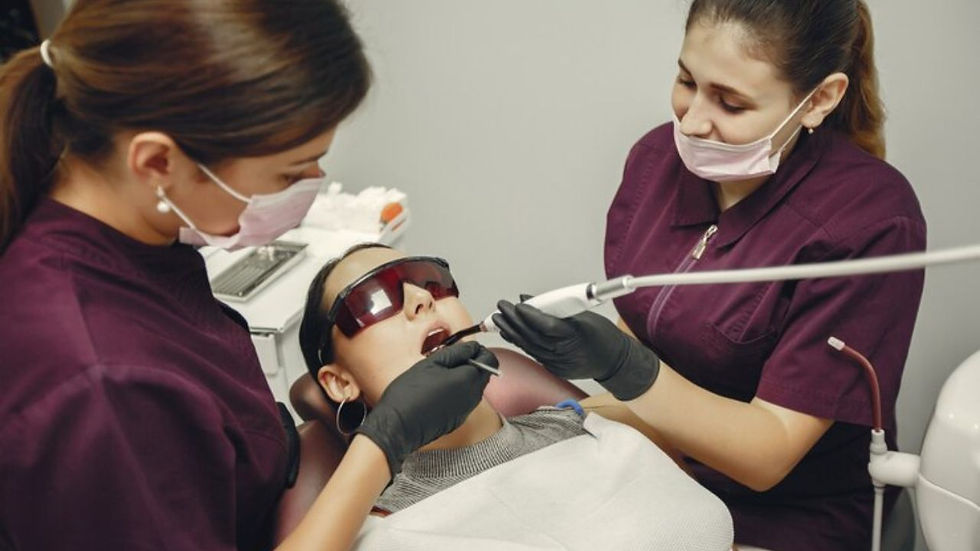Understanding Different Types of Sedation: From Mild to Deep
- Grin Pediatric Dentistry
- Sep 10, 2024
- 3 min read

When it comes to dental care for children, ensuring their comfort and reducing anxiety is a top priority. Sedation dentistry offers various options to help children feel at ease during dental procedures. Understanding the different types of sedation, from mild to deep, can help you make informed decisions about your child’s dental care. At Grin Pediatric Dentistry,
serving families in Plano, TX, and Dallas, TX, we prioritize your child's well-being by offering a range of sedation options tailored to their needs.
What is Sedation Dentistry?
Using medicine to assist patients relax during dental operations is known as sedation dentistry. Children who may be scared, nervous, or find it difficult to sit still will find it extremely helpful. The intention is to establish a peaceful space in which dental care can be given in a safe and efficient manner.
1. Mild Sedation (Nitrous Oxide)
What is Mild Sedation?
Mild sedation, commonly known as laughing gas, is the lightest form of sedation used in dentistry. It involves inhaling nitrous oxide mixed with oxygen through a small mask placed over the nose. The gas helps the child relax while remaining fully conscious and responsive during the procedure.
How Does Mild Sedation Work?
Mild sedation takes effect quickly, usually within a few minutes. Your child will feel calm and may experience a sense of euphoria, which helps reduce anxiety. The effects of nitrous oxide wear off almost immediately after the mask is removed, allowing your child to resume normal activities soon after the appointment.
When is Mild Sedation Used?
Mild sedation is often used for routine dental procedures such as cleanings, fillings, and extractions. It’s ideal for children who need a little help relaxing but don’t require deeper sedation.
2. Moderate Sedation (Oral Sedation)
What is Moderate Sedation?
Moderate sedation involves administering oral medication, usually in the form of a liquid or pill, to help your child relax. The medication is typically given about 30 minutes to an hour before the procedure to allow time for it to take effect.
How Does Moderate Sedation Work?
With moderate sedation, your child will feel drowsy and relaxed but will remain conscious and able to respond to verbal cues. The level of sedation can vary depending on the dose and the child’s response to the medication. Some children may become so relaxed that they fall asleep during the procedure.
When is Moderate Sedation Used?
Moderate sedation is often recommended for more involved dental procedures or for children who experience higher levels of anxiety. It’s also suitable for children who may have a strong gag reflex or difficulty staying still for an extended period.
3. Deep Sedation (IV Sedation)
What is Deep Sedation?
Deep sedation, is a more intense form of sedation that is administered intravenously. This type of sedation is typically reserved for more complex dental procedures or for children with extreme anxiety or special needs.
How Does Deep Sedation Work?
During deep sedation, your child will be in a sleep-like state and will not be aware of the procedure. Although they may be able to respond to strong stimuli, they won’t have any memory of the procedure afterward. The sedation is administered by a qualified anesthesiologist who monitors your child’s vital signs throughout the procedure to ensure their safety.
When is Deep Sedation Used?
Deep sedation also known as IV Sedation is used for extensive dental work, such as multiple tooth extractions or complex restorative procedures. It’s also an option for children who may not respond well to milder forms of sedation or who have medical conditions that make dental care challenging.
Choosing the Right Sedation for Your Child
Selecting the appropriate level of sedation depends on several factors, including your child’s age, anxiety level, and the complexity of the procedure. At Grin Pediatric Dentistry, our experienced team will work with you to determine the best option for your child. Whether you’re looking for a Pediatric Dentist near you in Plano, TX, or Dallas, TX, we’re here to provide compassionate, expert care tailored to your child’s needs.
Understanding the different types of sedation, from mild to deep, can help you make informed decisions about your child’s dental care. Sedation dentistry offers a safe and effective way to ensure your child’s comfort during dental procedures. At Grin Pediatric Dentistry, we’re committed to making every dental visit a positive experience for your child. Please get in touch with us right now if you would like to make an appointment or if you have any concerns regarding sedation options.


Comments